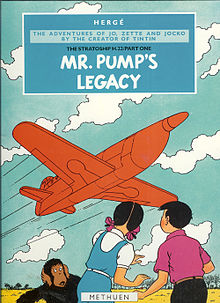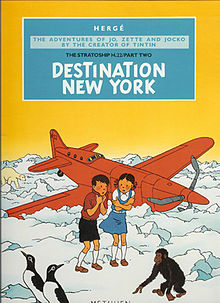- Jo, Zette and Jocko
-
Jo, Zette and Jocko Publication information Publication date 1935-1958 Main character(s) Jo
Zette
JockoCreative team Writer(s) Hergé Artist(s) Hergé The Adventures of Jo, Zette and Jocko is a comic book (or bande dessinée) series created by Hergé, the Belgian writer-artist who was best known for The Adventures of Tintin. The heroes of the series are two young children, brother and sister Jo and Zette Legrand and their pet monkey Jocko.
Jo, Zette and Jocko appear on the rear covers of some editions of The Adventures of Tintin series but never appear in the stories, while there are a few cheeky allusions to the cosmos of the Tintin adventures within the Jo, Zette and Jocko albums.
Contents
Publication history
In 1935, six years after Tintin had first appeared in the pages of Le Petit Vingtième, Hergé was approached by Father Courtois, director of the weekly French newspaper Coeurs Vaillants (Valiant Hearts). Coeurs Vaillants also published Tintin's adventures, but while Father Courtois enjoyed Tintin, he wanted a set of characters that would embody classical family values — a young boy, with a father who works, a mother, a sister and a pet — in contrast to the more independent Tintin who, the whole of his career, has had no mention of relatives at all.
Inspired by a toy monkey called Jocko, Hergé created Jo Legrand, his sister Zette and their pet monkey Jocko as well as their engineer father, Jacques, and housewife mother. Their first adventure, The Secret Ray appeared in the pages of Coeurs Vaillants on January 19, 1936 and ran until June 1937.[citation needed] It was also published in Le Petit Vingtième itself.
Between 1936 and 1957, three complete Jo, Zette and Jocko adventures would be published, spread across five albums. Hergé however often felt restricted by the family set-up: whereas the older, more independent Tintin could just head off on any adventure, either alone or with Captain Haddock or Professor Calculus, this was not possible for Jo, Zette and Jocko whose parents had to figure large in any adventure — usually to act as their rescuers. The stories also lacked the social and political messages of the Tintin stories. In the end, these constraints led him to eventually abandon Jo, Zette and Jocko in the late-1950s.
Bibliography
The Secret Ray
1. The ‘Manitoba’ No Reply
(Le Manitoba ne répond plus)
(Volume 1 of The Secret Ray)
The transatlantic liner Manitoba breaks down on its way to England and then the passengers and crew fall strangely asleep. When they wake up it is to find that they have all been robbed of their valuables. Later, while on holiday at the seaside, Jo, Zette and Jocko, playing in a rowing boat, get lost at sea when a thick fog comes down. Rescued by a submarine, they are taken to a secret undersea base where a mad scientist has plans for the two young children.2. The Eruption of Karamako
(L’Eruption du Karamako)
(Volume 2 of The Secret Ray)
Jo, Zette and Jocko escape the undersea base in an amphibious tank, and end up on an island. But their problems are far from over. They have to deal with cannibals, modern-day pirates, an erupting volcano, gangsters, the media and there is still the mad scientist who wants them for his evil plans.
(In one scene Zette is harassed by a representative of Cosmos Pictures which was run by Tintin's enemy Rastapopoulos.)Mr. Pump’s Legacy
3. Mr. Pump’s Legacy
(Le Testament de Monsieur Pump)
(Volume 1 of The Stratoship H.22)
Killed while exercising his love for speed in a racing car, millionaire John Archibald Pump leaves behind ten million dollars (a staggeringly large sum for those days). It will go to the builders of the first aeroplane to fly from Paris to New York at 1000 kilometres per hour. Jo and Zette's father sets about designing such a plane, but the project comes under threat from a gang of saboteurs led by William and Fred Stockrise, Pump's passed-over nephews, who go to all lengths, from theft to bombing, to prevent it.
(A framed photo of Captain Haddock can be seen hanging on the wall of the Legrand living-room just before Mr Legrand switches on the light to confront intruders.)4. Destination New York
(Destination New York)
(Volume 2 of The Stratoship H.22)
When the Stratoship H.22, designed by their father, is the subject of an attempted bombing from the air, Jo and Zette fly it out of its hangar but are unable to get back. Crash-landing near the North Pole they face a race against time to get the plane back home and win the trans-Atlantic challenge. But the Stockrise brothers and their gang are still determined to thwart the operation even if it is successful.The Valley of the Cobras
5. The Valley of the Cobras
(La Vallée des cobras)
The Maharajah of Gopal is a bad-tempered sort of person, whose behaviour ranges from the childish to the eccentric, and his long-suffering secretary Badalah is usually on the receiving end. Nevertheless, Jo and Zette's father agrees to build him a bridge in his kingdom. The problem is there is a group of scoundrels led by Prime Minister Ramahjuni and the evil fakir Rabindah who aren't too keen on the idea.Influence on other works
Aspects of the animated film Tintin and the Lake of Sharks (1972), which was not produced by Hergé himself but issued under his name, appears to borrow some elements from the Jo, Zette and Jocko adventure The Secret Ray:
- like in The ‘Manitoba’ No Reply, two children, Niko and Nushka, attempt to escape from an underwater base in a tank-like vehicle;
- like in The Eruption of Karamako, the underwater compound is destroyed by its evil leader in an attempt to drown his pursuers;
- there is the interaction of children and adults during the final escape;
- and the friends waiting above water and thinking the heroes have been killed when the compound explodes.
Le Thermozéro
Le Thermozéro is the sixth, incomplete, Jo, Zette and Jocko adventure. It began in 1958 as a Tintin adventure of the same name. Hergé had asked the French comic book creator Greg (Michel Regnier) to provide a scenario for a new Tintin story. Greg came up with two potential plots: Les Pilules (The Pills) and Le Thermozéro. Hergé made sketches of the first eight pages of Le Thermozéro [1] before the project was abandoned in 1960 – Hergé deciding that he wished to retain sole creative control of his work.
Sometime after this, Hergé sought to resurrect Le Thermozéro as a Jo, Zette and Jocko adventure and instructed his long time collaborator Bob de Moor to work on an outline. Bernard Tordeur of the Hergé Foundation has suggested, at the World of Tintin Conference held at the National Maritime Museum, Greenwich on May 15, 2004, that a complete draft outline (similar to what survives of Tintin and Alph-Art) was completed before the project was terminated [2] This draft version of the book apparently survives in the Tintin Archives.[citation needed]
English translations
The Valley of the Cobras was the first Jo, Zette and Jocko adventure to be translated and published in English in 1986. Mr Pump’s Legacy and Destination New York followed in 1987.
The ‘Manitoba’ No Reply and The Eruption of Karamako remained unpublished (possibly due to Hergé’s unsympathetic depiction of the primitive natives of the island of Karamako, similar to Tintin in the Congo) until 1994 when they were published together in a single limited-edition double volume titled The Secret Ray.
Sources
- Jo, Zette et Jocko publications in Belgian Tintin and French Tintin BDoubliées (French)
- Footnotes
External links
Categories:- Belgian comics titles
- Works by Hergé
Wikimedia Foundation. 2010.




